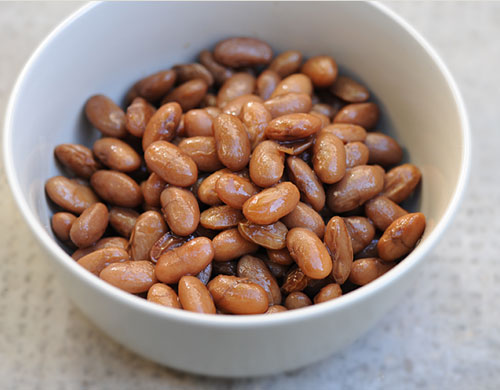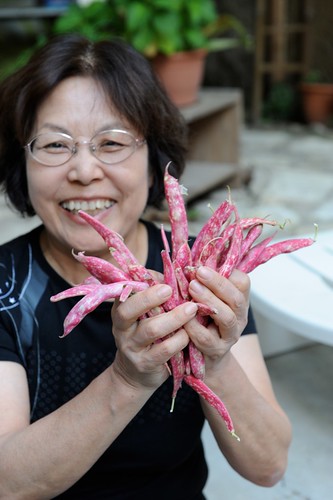Bento filler and staple: Sweet stewed haricot, navy or white beans (Ingen no nimame)

Nimame (煮豆 にまめ), or stewed beans, are a standby item for bentos. They are usually rather sweet, though not dessert-level sweet, and serve the purpose of a hashi yasume or "chopstick rest" (see anatomy of a Japanese meal), a little something that contrasts in flavor and texture from the rest of the bento.
While it takes rather long to cook these, like most bean dishes, this is a terrific staple item. The beans keep for at least a week in the refrigerator, and freeze well in small batches too. Tuck in a spoonful in any bento for something a little sweet, a little salty, and good for you.
You can make nimame with any kind of dried beans, but here I've specified white or navy beans, or haricot beans, which are widely available and inexpensive. You could use cannellini beans instead.
You'll notice that the only remotely exotic ingredient used here is soy sauce, so anyone can make this! Yes it's still authentically Japanese. (It's another one of my mom's recipes.)
Recipe: Sweet stewed haricot, navy or white beans (Ingen no nimame)
- 200 g / about 7 oz. or 2 U.S. cups of dry white or navy or haricot beans
- 50g / about 1/4 cup raw cane sugar or sucanat; you can use white sugar or your preferred artificial sugar substitute here
- 1/2 tsp. baking soda (重曹 じゅうそう juusou in Japanese)
- About 1 Tbs. soy sauce
- A drizzle of honey (optional)
Sort through the beans and take out any broken ones or small stones, etc. Rinse the beans and cover with plenty of water in a large pot or bowl. Leave for at least 4 hours or overnight.
Drain the soaking water away, and put the beans in a pot with fresh water to cover. Bring to a boil, then throw away the water. This gets rid of much of the surface scum on the beans. Rinse the beans again, and fill the pot with more fresh water. Add the baking soda to the water. (The baking soda helps to make the beans more tender, but you can omit it.)
If you're cooking the beans conventionally, bring the beans to a boil, lower the heat, and cook for about 40 minutes to an hour until the beans are firm but tender. You can tell when they are tender by taking one out and eating it!
You can also use a crockpot or slow cooker in the same way, though it may take longer to cook.
If using a pressure cooker: Close the lid, and heat the pot until it's up to pressure, then lower the heat and cook for about 5 minutes. Release the pressure until you can open the lid. (Follow the manufacturer's instructions.)
Add the sugar to the pot, and simmer for about half an hour. This gives them that caramel color. Add the soy sauce and the honey, and simmer for an additional 10-15 minutes. (You can add these with the sugar if you want to save some steps, but the beans won't be as shiny and burnished.)
Use a paper or aluminum foil otoshibuta
This is optional, but if you want really perfect beans, you'll want to use a temporary "lid" made of a piece of parchment paper or aluminum foil, crumpled up to fit right on top of the beans in the pot, with holes poked in it, for the second stage of the cooking process (when you add the sugar) onwards. This is called an otoshibuta (落としぶた)and the rationale for using it is explained in this recipe for stewed eggplant.
Using undried fresh beans
If you can get a hold of undried fresh beans, you can use them instead of dried beans. You don't need to soak them in advance. Here my mother is holding up a bunch of coco rouge, a type of fresh bean that is available in the markets in Provence from mid-summer to fall. (I believe they are borlotti beans or cranberry beans, or very close to them.) Yep, she really loves her beans, which is why she's looking so happy! (Well that and the sun, weather, and whole vacation thing.)
If you enjoyed this article, please consider supporting this site by becoming my patron via Patreon.

